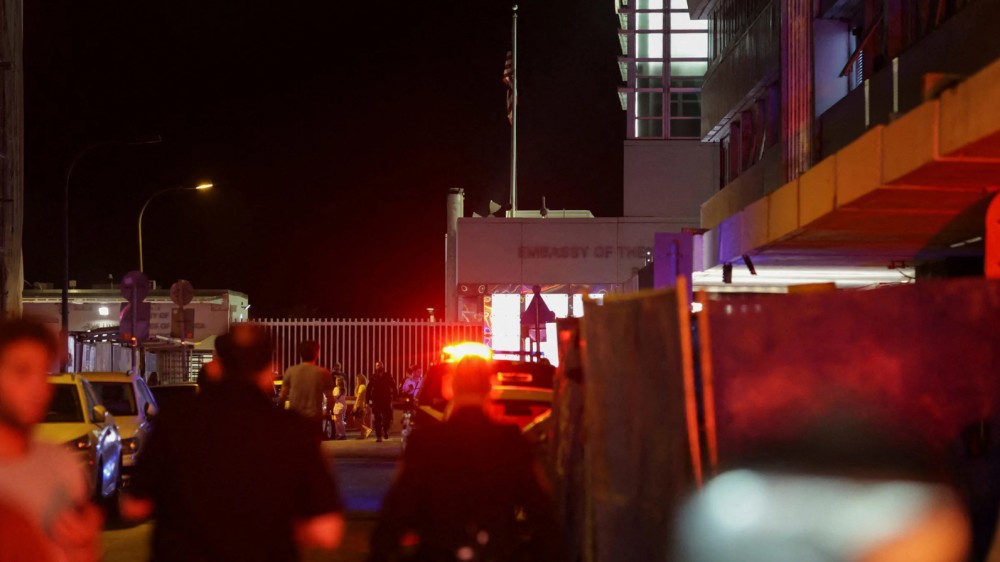Israel investigates security failures around deadly Tel Aviv drone strike


Jack Lew, the US Ambassador to Israel, said Friday he was “shocked by the brazen Houthi drone attack” and sent his condolences to the victims’ families. “We are thankful our US Embassy Branch Office personnel are safe,” he added. Israel authorities are investigating the circumstances and potential security lapses around a deadly drone blast in Tel Aviv that killed one man and injured at least 10 others on Friday.
The attack was claimed by Yemen’s Houthi rebels, in what the Iranian proxy group said was a response to Israel’s war in Gaza. Houthi spokesperson Yahya Sare’e said the operation was performed by a new drone capable of “bypassing the enemy’s interception systems.”
“We will continue to strike these targets in response to the enemy’s massacres and daily crimes against our brothers in the Gaza Strip,” Sare’e said. “Our operations will only cease when the aggression stops and the siege on the Palestinian people in the Gaza Strip is lifted.”
The attack marked the first time Tel Aviv, Israel’s commercial center, has been struck by a drone in an attack claimed by the Houthis.
In a televised briefing on Friday, Israel Defense Forces (IDF) spokesman Daniel Hagari said that the military suspects the drone was an Iranian-made Samad-3 model, launched from Yemen, which had been upgraded to extend its range.
A second drone was intercepted outside of Israeli territory to the east at the same time as the attack, he said, adding that Israel is now upgrading its air defenses and increasing aerial patrols of its borders.
An Israeli military official said the drone was detected by an Israeli aerial defense system, but not intercepted due to “human error.” It was armed with a warhead and crashed into an apartment building, the official added, without providing further details of the device’s payload.
The official didn’t provide details about what the human error was but noted that Israel’s aerial defense systems don’t always operate autonomously. The Iron Dome defense system, for example, can operate in manual mode, where its radar detects and tracks incoming threats but needs input from an operator before launching an interceptor missile.
According to an initial inquiry “no sirens were activated” during the incident, the IDF said earlier.
Deadly explosion
The explosion occurred in a central district home to a number of diplomatic missions, and hit about 100 meters (330 feet) from a US Embassy branch office.
There was no damage to the US diplomatic mission and no reports of injuries of US personnel or “locally engaged staff,” the US State Department said.
“We are in close contact with Israeli authorities to fully investigate the source of the explosion and its intended target,” the spokesperson said, adding the embassy in Jerusalem and the branch in Tel Aviv are ready to provide consular assistance to US citizens.
Emergency crews responded to “an object” that had exploded on Shalom Aleichem Street, Israel’s Magen David Adom (MDA) emergency service said.
“The dead man had suffered penetrating injuries,” MDA paramedic Roi Klein said. At least four of the injured sustained shrapnel wounds, the MDA said.
Israeli far-right National Security Minister Itamar Ben Gvir and opposition leader Yair Lapid criticized the Israeli government for being unable to protect the country, saying on social media that the attack showed the government “cannot give security to the citizens of Israel.”
There are no policies, no plans, all public relations and discussions are about themselves,” he said.
Ben Gvir said the attack on Tel Aviv and other areas of Israel are “precisely why I insist on being around the table in determining Israel’s policy.”
Israeli Prime Minister Benjamin Netanyahu in June disbanded the country’s war cabinet after former war cabinet member Benny Gantz announced his withdrawal from the body, and Ben Gvir asked to join.
Houthi attacks
The Yemeni rebels have regularly targeted Israel with drones and missiles since the start of the country’s war with Hamas, most of which have been intercepted by Israel’s defenses.
The Houthis have also been attacking US targets and commercial shipping in the Red Sea since Israel launched its invasion of Gaza following Hamas’ October 7 attack, in which more than 1,200 people were killed and more than 250 others kidnapped.
Israel’s air and ground offensive on Gaza has killed more than 38,000 people in the enclave, according to Palestinian authorities. The war has displaced almost all of the strip’s population of more than 2 million people, turned swaths of the territory into rubble and triggered a massive humanitarian crisis.

By Jamal Al-Awadhi For years, Yemen has been treated by the international community as a marginal conflict an unfortunate…

AbuDhabi -- The U.S. State Department announced Thursday that Secretary of State Marco Rubio held a phone call with UAE Foreign Minister Sheikh Abd…

Baghdad — The Iraqi government announced the dismissal of several officials following controversy over the inclusion of Lebanon’s Hezbo…